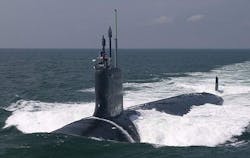Lockheed Martin moving to next-generation sonar signal processing for new Virginia-class submarines
Officials of the Naval Sea Systems Command in Washington last week awarded a $71.6 million contract to the Lockheed Martin Mission Systems and Training segment in Manassas, Va., for engineering and long-lead materials for the Acoustics-Rapid COTS Insertion (A-RCI) technical insertion (TI) 16 program.
This long-lead-item contract will enable Lockheed Martin to buy components and equipment that typically take a long time to acquire so the company can complete the final sonar installation as soon as possible during construction of the four Virginia-class boats.
A-RCI is a sonar system that integrates and improves towed array, hull array, sphere array, and other sonar signal processing aboard Navy submarines through rapid insertion and rapid upgrades of COTS-based hardware and software.
The A-RCI TI-16 sonar program involves vast improvements in acoustic sensing by using the latest commercially developed digital signal processing technology to enhance submarine sonar performance without changing the actual sonar sensors aboard the Virginia-class submarines.
Related: Lockheed Martin to make COTS upgrades to submarine sonars in $29.4 million contract
The contract calls for Lockheed Martin to support the Virginia-class submarine's large aperture bow array (LAB), lightweight wide-aperture array (LWWAA), legacy replacement, and EC-20 high-frequency sonar array upgrade.
The company also will start developing improvements for new and modified acoustic sensor systems, upgrade common forward-fit and back-fit networking, and move advanced processing builds (APBs) into their specific submarines, trainers, and shore-based facilities.
The long lead materials contract is necessary for the program to maintain schedule, officials say. Purchasing all necessary long lead material ensures that the Navy and Lockheed Martin will receive a cost break, Navy officials say.
For more information contact Lockheed Martin Mission Systems and Training online at www.lockheedmartin.com/us/mst, or Naval Sea Systems Command at www.navsea.navy.mil.
